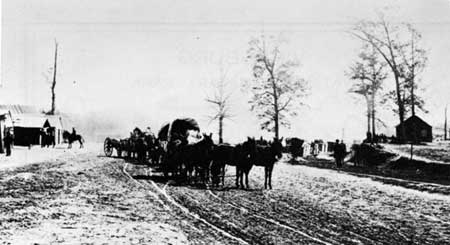|
VICKSBURG National Military Park |
 |

Wartime photograph of a Union supply station on the Big Black
River in rear of Vicksburg.
Courtesy Library of Congress.
The Vicksburg
Campaign: Grant Moves Against Vicksburg— and
Succeeds (continued)
THE BATTLE OF BIG BLACK RIVER. Not knowing that Loring's Division had been cut off, Pemberton made a stand at the Big Black River in order to hold the bridges open for Loring to joint the main force. The Confederate entrenchments spanned the river at a readily defensible location where the stream made a horseshoe bend. Across the mile-wide neck of the river the Confederates constructed a line of works, and behind the earthworks, with their backs to the river, were placed 4,000 infantry of Bowen's Division supported by artillery.
Before dawn on the 17th the Union Army pushed on toward Vicksburg. Grant, still hoping to win the race for Vicksburg, had dispatched Sherman's Corps to the north to pass the retreating Confederate Army as Grant engaged it from the front. At an early hour the Federal troops came in sight of the Confederate line, whereupon they opened an artillery barrage and deployed to assault. Before the deployment was complete, Brig. Gen. Eugene A. Carr's Division charged "with a shout" from the woods fronting the Confederate position. Realizing the danger of their position, where they might be cut off from the crossing to their rear, the Confederate troops broke and headed for the bridges in disorder. After the withdrawal, the bridges were burned, effectively halting Union pursuit. In the confusion, Grant captured over 1,000 prisoners along with 18 artillery pieces.
While Pemberton's Army retreated into the defenses of Vicksburg, Grant's engineers immediately began construction of bridges across the Big Black River, using trees, cotton bales, and lumber from nearby buildings as bridging materials. Sherman's Corps, which had struck the river 11 miles to the north attempting to outflank Pemberton and prevent his retreat to Vicksburg, threw a pontoon bridge across the river at that point. By light of pitch torches, the bridges were completed during the night. On the following morning, May 18, troops crossed en route to Vicksburg.

|
|
Last Modified: Mon, Dec 2 2002 10:00:00 am PDT |


